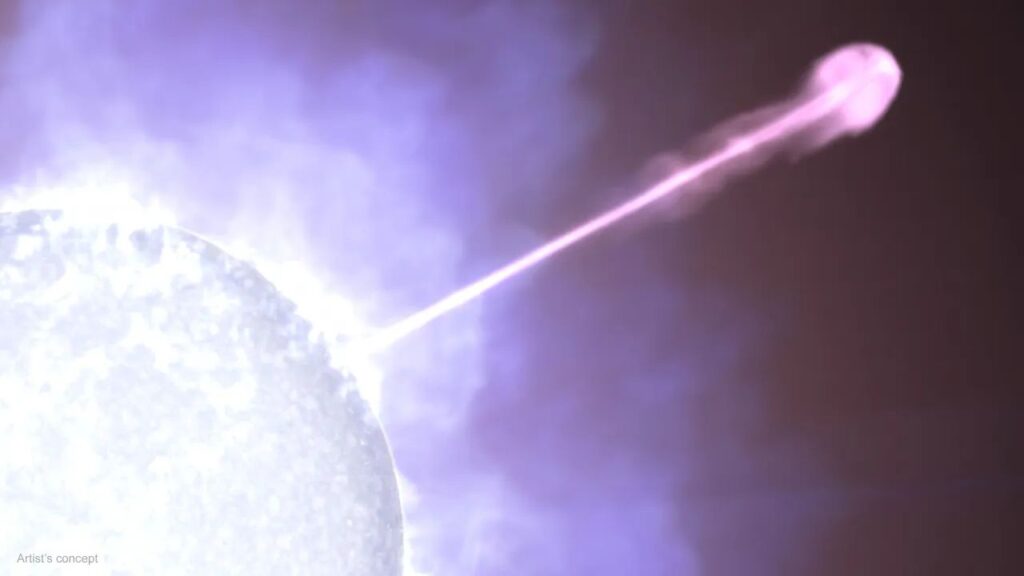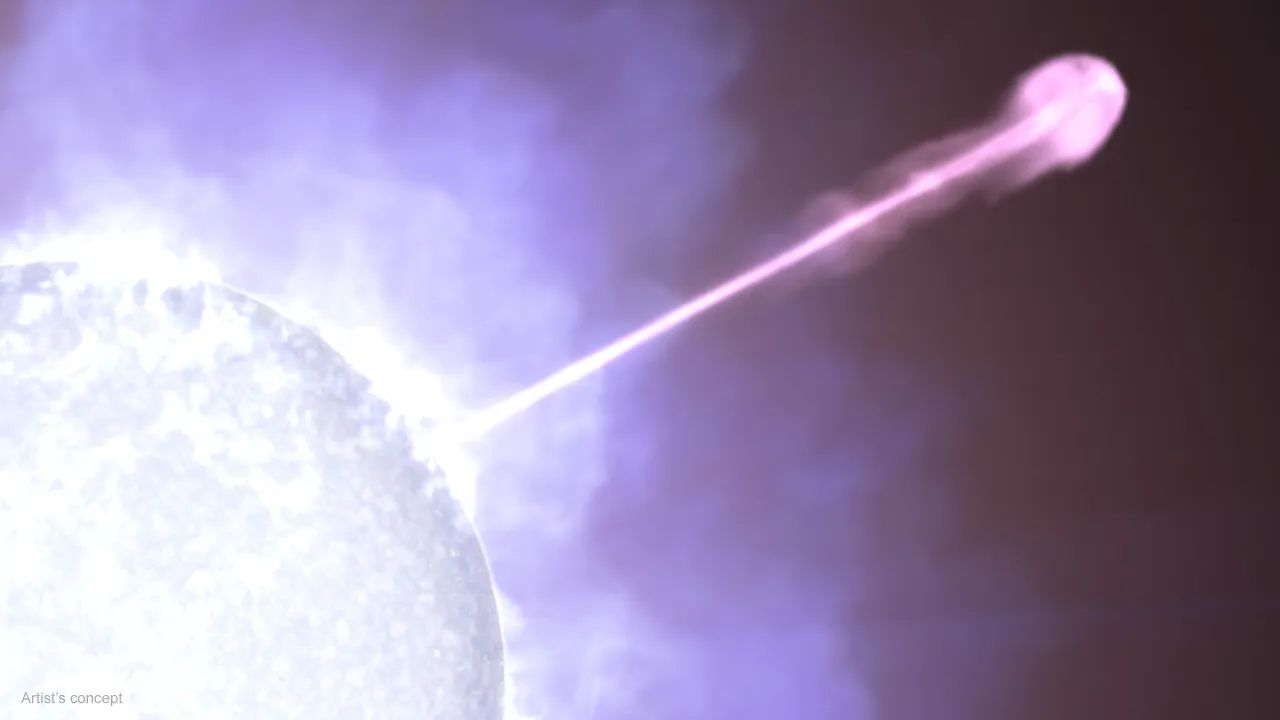NASA Fermi Telescope, brightest gamma-ray burst, GRB 221009A, BOAT gamma-ray burst, gamma-ray astronomy, high-energy astrophysics, Maria Edvige Ravasio, gamma-ray burst discovery, gamma-ray burst emission line, electron-positron annihilation, gamma-ray burst jets
Discover the groundbreaking findings from NASA’s Fermi Gamma-ray Space Telescope, which revealed a unique emission line in the brightest gamma-ray burst ever recorded. Learn about the significance of this discovery and its implications for understanding cosmic explosions.

NASA’s Fermi Finds New Feature in Brightest Gamma-Ray Burst Yet Seen
In October 2022, astronomers witnessed an event that took the astronomical community by storm—the BOAT (Brightest of All Time) gamma-ray burst (GRB). This extraordinary phenomenon, officially known as GRB 221009A, has now revealed even more astonishing secrets. An international team of scientists, analyzing data from NASA’s Fermi Gamma-ray Space Telescope, discovered a never-before-seen feature in the aftermath of the burst. Lead researcher Maria Edvige Ravasio at Radboud University, along with her team, found an unusual energy peak a few minutes after the GRB, marking the first high-confidence emission line observed in 50 years of GRB study.
The Discovery
The BOAT burst, which erupted on October 9, 2022, was so intense that it saturated most gamma-ray detectors in orbit, including those on the Fermi telescope. This saturation made it impossible to measure the peak intensity directly. However, reconstructed observations and statistical analyses suggest that the BOAT could be the brightest GRB to appear in Earth’s skies in the past 10,000 years.
Fermi’s Gamma-ray Burst Monitor (GBM) detected an unexpected energy peak five minutes after the initial burst. This peak, which persisted for at least 40 seconds, reached an energy of about 12 MeV (million electron volts), a significant departure from the energy of visible light, which ranges from 2 to 3 electron volts.
Understanding Gamma-Ray Bursts
Gamma-ray bursts are the most powerful explosions in the universe, emitting massive amounts of gamma rays, the highest-energy form of light. The most common type of GRB occurs when the core of a massive star exhausts its fuel, collapses, and forms a rapidly spinning black hole. This process powers oppositely directed particle jets that blast through the star’s outer layers at nearly the speed of light. Earth-based observers detect GRBs when one of these jets points directly toward our planet.
The Significance of the Emission Line
The detection of this emission line is groundbreaking. When matter interacts with light, it can absorb and reemit energy in characteristic ways. These interactions produce spectral features that can reveal the chemical elements involved or specific particle processes, such as matter-antimatter annihilation. In this case, the emission line detected by Fermi is believed to result from the annihilation of electrons and positrons (the antimatter counterpart of electrons).
“When an electron and a positron collide, they annihilate, producing a pair of gamma rays with an energy of 0.511 MeV,” explained Gor Oganesyan from the Gran Sasso Science Institute and Gran Sasso National Laboratory in Italy. The observed emission line, peaking at 12 MeV, suggests that the particles were moving towards us at about 99.9% the speed of light. This remarkable blueshift occurs because we are looking into the jet of particles moving at relativistic speeds.
Implications for Astrophysics
This discovery is a major step forward in our understanding of GRBs and the extreme environments in which they occur. “After decades of studying these incredible cosmic explosions, we still don’t understand the details of how these jets work,” said Elizabeth Hays, Fermi project scientist at NASA’s Goddard Space Flight Center. The detection of the emission line provides a valuable clue that could help scientists unravel the mysteries of GRB jets.
The Role of Fermi Gamma-ray Space Telescope
The Fermi Gamma-ray Space Telescope, an astrophysics and particle physics partnership managed by NASA’s Goddard Space Flight Center, has been pivotal in this discovery. Developed in collaboration with the U.S. Department of Energy and academic institutions from France, Germany, Italy, Japan, Sweden, and the United States, Fermi has significantly advanced our understanding of high-energy cosmic phenomena.
Future Research and Exploration
The detection of the emission line in the BOAT GRB opens new avenues for research. Scientists will now look for similar features in other GRBs to determine whether this is a common phenomenon or a rare occurrence. This will involve re-examining data from past GRBs and closely monitoring future bursts.
Further study of this emission line will also require more detailed theoretical models to understand the exact conditions under which such high-energy interactions occur. This could involve simulations of particle interactions in relativistic jets and comparisons with observational data.
Conclusion
The discovery of a high-confidence emission line in the BOAT GRB represents a monumental achievement in astrophysics. It underscores the importance of continued observation and analysis of gamma-ray bursts to uncover the secrets of these powerful cosmic events. The Fermi Gamma-ray Space Telescope, with its sophisticated instruments and international collaboration, remains at the forefront of this exciting field of study.
As scientists delve deeper into the data from GRB 221009A and other gamma-ray bursts, we can expect to learn more about the fundamental processes that drive these extraordinary explosions. Each new discovery brings us closer to understanding the complex and dynamic universe we inhabit.
This groundbreaking finding not only enhances our knowledge of gamma-ray bursts but also demonstrates the incredible capabilities of modern astronomical instruments. The Fermi Gamma-ray Space Telescope continues to push the boundaries of what we know about the universe, revealing phenomena that challenge our understanding and inspire further exploration.
Read More
- Aya Nakamura: The Rising Star of French Pop Music and the Paris Games Opening Ceremonies Performer
- Gojira: The Heavy Metal Sensation at the 2024 Olympics Opening Ceremony
- Search GPT OpenAIs Revolutionary AI Search Engine Challenging Google
- NASAs Fermi Telescope Unveils Unprecedented Feature in Brightest Gamma Ray Burst
